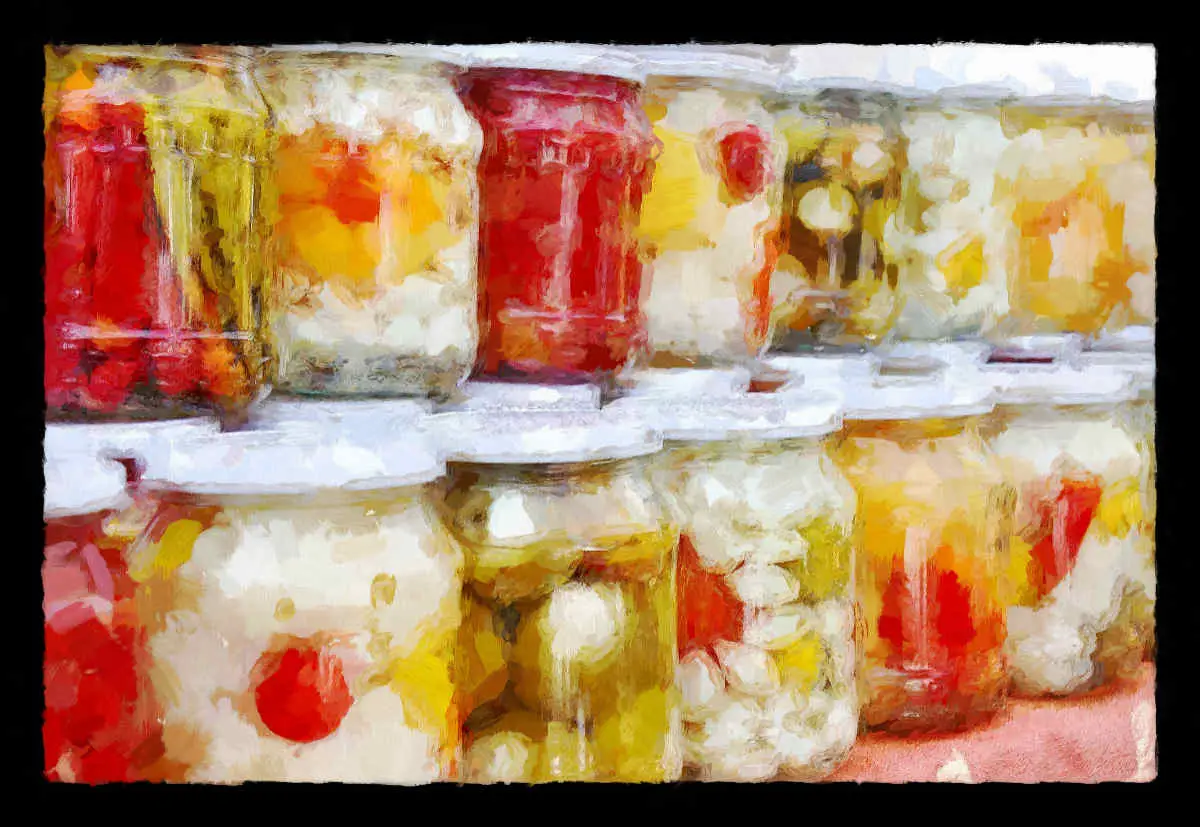Homemade Sauerkraut – Our Best Recipe
Sauerkraut is nothing more than cabbage and salt. Use the right salt ratio, wait some time and your homemade sauerkraut will be ready to eat.
Did you know that sauerkraut, literally “sour cabbage”, are just cabbage and salt, aka fermented cabbage?
Such a simple food and yet one of the healthiest and most beneficial to the human body.
If we think about it, the way cabbage and vegetables in general are enhanced by fermentation is really quite remarkable…
That’s why we decided to share with you the easiest way we know to make sauerkraut.
So that you too can begin to enjoy this wonderful, tasty, gut-enriching food.
We will get to that in a moment.
DID YOU KNOW? In Germany traditional sauerkraut is the main ingredient of numerous foods, like soup ‘sauerkrautsuppe’, and is the hot and cooked base for many meat or bratwurst dishes.
Fermenting cabbages at home can also be a great way to explore recipes we have never tried before like those mentioned above, which, in all honesty, sound quite delicious.
Or they can become part of a simple yet delicious way of cooking.
Pair them with a sausage or a wurstel, a slice of warm sourdough bread, a spoonful of Shatta sauce and some finely chopped lacto fermented fruits mixed with fermented garlic scapes.
Yum-my!
And the brine? Aside being a well known “gut shot” it can be used as the secret, tasty ingredient of fermented cocktails.
TELL YOUR FRIENDS
In order to prepare the best sauerkraut we need to start with good ingredients ( cabbage and salt ), a clean working area and sterilised equipment.
Don’t worry you won’t need anything fancy, just some jars with lids, a bowl and a few other things.
Let’s start with the cabbage.
Cabbage
Although the tendency is to ferment white and green cabbage, all other types will work too, as long as the heads are fresh, firm and possibly organic.
In fact “coloured” cabbages, like the red ones, will produce a show stopping vibrant red/hot pink sauerkraut definitely worth making.
When choosing between two heads of cabbage, always remember to pick the heavier one rather than the lighter as the heavier one will contain far more juice.
The reason for it is that cabbage juice plays quite an important role in the fermentation process as we are about to see.
Salt
When it comes to salt our preference is to use mined rock salt with the exception of the Himalayan one and anything with added iodine.
Most of the times when we make sauerkraut we prefer to use the dry salting method over adding a brine, but both methods produce equally good results.
Feel free to choose the one that suits you the most.
Just like the word explains dry salting involves applying salt onto a vegetable with the purpose of extracting the juices it contains.
The mix of salt and water extracted from the vegetable will become the brine which vegetables themselves will lacto ferment in for the chosen amount of time.
Would You Like
YOUR FERMIE LIFE
To Be EASIER?
Our FERMENTATION
PRINTABLES Will Do
Exactly That.
Fermenting Vessel – Use A Jar
As you might know traditional sauerkraut was fermented inside ceramic crocks.
Shredded cabbage and salt were placed inside the vessels, weighed down and left covered with a lid for the time needed.
In our kitchen we have taken the essence of that process and turned it into a very easy fermentation process that saves you hundreds of dollars ( ceramic crocks are very pricey ).
In fact we make sauerkraut in a glass jar.
Here is how.
THE BEST Sauerkraut salt ratio
Knowing the best salt to sauerkraut ratio can be a shot in the dark as the number offered around the web vary significantly.
From 1% to 2 – 2.2%, usually.
But in our house, when it comes to the food we eat and our health we prefer to go by science.
According to this recent study, the best salt ratio for sauerkraut is 2.5%.
By using this salt concentration you are assured to obtain sauerkraut that are not only delicious to eat, but that also contain the highest population of Lactic Acid Bacteria.
This is because, with 2.5% of salt by weight, the glucose contained in the cabbage is consumed by microorganisms in a more complete way and higher amounts of organic acids are formed.
So now that we know the amount of salt we need let’s learn how to calculate it.
Calculate salt
The first thing to do is to understand how to properly calculate the amount of salt you need for your recipe.
The best way to achieve that is with the metric system as it’s far more accurate than the imperial units.
Proceed this way ( don’t worry, it’s easy )
Multiply the weight of the cleaned cabbage by 0.025 and the resulting number will be the grams of salt necessary to safely complete the lacto-fermentation.
As an example let’s say the weight of the cabbage is 1500 grams
1500 x 0.025 = 37.5 grams
Which we can round to 37 or 38.
Awesome, now that you know how much salt you need we can continue with the recipe!
Join Our Community
Home Made Sauerkraut – BEST RECIPE
This recipe will work for any amount of kraut you intend to make.
INGREDIENTS
- Fresh cabbage head(s)
- Salt
STEPS
- Take a fresh and heavy cabbage head and remove core and outside leaves ( but keep one or two of them )
- Weigh it
- Cut it finely by hand or with a food processor and place it into a large bowl
- Pour salt over the cabbage, mix well and start massaging to help the salt penetrate.
- Continue for a few minutes then cover the bowl and let it rest for 20 to 30 minutes.
- Massage again then allow to rest.
- Keep alternating massaging and resting process until two hours have passed.
- Now you should see that a significant amount of juice has been extracted from the cabbage.
- Pour everything in a jar leaving enough headspace (3 cm / 1 inch)
- With a fist or a pestle, pack cabbage tightly. Place one of the outside leaves over the cabbage to help keep everything submerged under the brine.
- Seal the jar and let ferment for at least two weeks periodically unscrewing the lid to release some of the CO2
TIPS
*** Sometimes cabbage won’t produce enough water to submerge the ingredients; in that case just prepare a 2.5% brine and add it to the jar until everything is safely covered with it. ***
A quick FYI
In more cases than not you will see most of the sauerkraut brine disappear to the point where there is none left.
And sometimes you will see it happen overnight.
This is the moment when many beginners panic, but in reality there is nothing to worry about.
In fact it is absolutely normal.
This process is often referred to as sauerkraut brine evaporation
When you massage the shredded cabbage with salt you are actually extracting the majority of its juice.
As an obvious consequence there will be a time when that same juice is absorbed back by the cabbage.
The great thing is that cabbage won’t just absorb plain juice, but instead it will absorb fermented brine full of probiotics.
Probiotics that you will ingest and benefit from when eating the final product.
So as you have learnt calling it sauerkraut brine evaporation is actually incorrect as the liquid does not disappear or get lost.
It’s all still there, only in disguise.
Now, that was an easy sauerkraut recipe wasn’t it?
Hmmm…I like it, you might say, but is there a way to skip all this massaging and all the waiting?
Of course there is.
Brined sauerkraut recipe
As the name suggests, in this recipe we will be adding water to the cabbage.
Same as above, this recipe will work for any amount you intend to make.
INGREDIENTS
- Fresh cabbage head(s)
- Salt
- Water
STEPS
Follow steps 1-2-3 from the previous recipe
- Weigh the empty jar on a scale and write down its weight
- Place all the shredded cabbage inside it and add water up to 3 cm ( 1 inch ) from the top then weigh it
- It’s math time! Weight of the full jar – ( Weight of cabbage + Weight of empty jar ) = Weight of water
- Write down the TOTAL weight of your ingredients ( cabbage + water ) and multiply it by 0.025 to determine how many grams of salt you’ll need
- Dissolve salt in water ( you can warm it up ) and add it to the jar where you had previously placed the cabbage
- Place a weight over the produce to keep it submerged at all times
- Seal it and let it ferment for a couple of weeks making sure to release CO2 when necessary
IMPORTANT
It goes without saying that by choosing brine over dry salting cabbage will not absorb the fermented solution back inside its cells.
And that’s obviously because no juice was extracted in the first place.
As a consequence, the final product won’t be as packed full of good microorganisms had it been made with the traditional dry salting method.
Sauerkraut is ready when…
When is sauerkraut ready? And how do I know when it is?
As many other things Nature-depending, there is no exact way to determine when sauerkraut IS ready.
But there are ways to determine when sauerkraut is ready for you.
And by that I mean that everyone likes sauerkraut a little different: some love them tangy and some others very tangy.
Then there are fermies who absolutely dislike sauerkraut with a vinegar taste.
As a general rule the longer you let the cabbage ferment the more tangy and vinegary it will be.
If you are a beginner I advise you to start tasting it after a couple of weeks to see if they have reached a flavour profile you are happy with.
If not simply let the jars sit for longer then taste again.
When we make ours we usually let them ferment for much longer, in the order of months, as we have already pinpointed the flavour profile we love.
But the first times you make it, tasting often is the most effective way to proceed.
How To Make Sauerkraut That Are NOT Mushy
Mushy sauerkraut are a fairly common issue so don’t worry, you are not alone.
But once you know what to do it’s also something very easily preventable.
As easy as reading the next 2 lines.
Opposite to other fermented vegetables, sauerkraut requires quite low temperatures.
Around 20 degrees Celsius (69 Fahrenheit)or below.
Keep the sauerkraut for a few days at room temperature to ensure fermentation starts correctly then move them to a colder room.
The ideal temperature of such room should range between 16° and 18° Celsius (61°-64° F)
Besides ensuring a smooth lacto fermentation, such temperatures will also keep the cabbage crispy whilst warmer temperatures could soften it and make it mushy.
On top of that, make sure to use the freshest cabbage heads.
Sauerkraut Shelf Life
How long does sauerkraut last once fermentation is completed?
When ready they can easily be stored for several months in cool dark places like ( root ) cellars and even for longer in the refrigerator.
Just make sure they are submerged by brine at all times.
Some people are concerned that with time their sauerkraut will become too tangy and acidic to eat.
If you are one of these people simply drain the brine ( if any is left ) and substitute it with a pickling liquid made with equal parts of water and vinegar.
You could also add a little sugar if you wish.
Sauerkraut Additions – Herbs and Spices
After you have practiced with the basic recipe you can surely experiment further by adding spices, herbs, other types of vegetables and even fruit.
There are some very tested and flavourful combinations you could try, like adding caraway seeds or peppercorn to the salty mix and let everything ferment together.
TELL YOUR FRIENDS
Many people add onions, some others carrots whilst if you were to ask for sauerkraut in certain areas of Europe you would be served a fermented mix of cabbage, carrots and apples.
Which is DIVINE by the way…
Last but not least.
If chopping and shredding is not something you are willing to put up with, you could make sauerkraut even with store bought shredded cabbage.
But in all honesty I cannot guarantee it would taste as good, or any good.
A great alternative to Sauerkraut is fermenting whole cabbage heads like the Greeks and the Romanians do.
There is zero massaging and rubbing involved.
Over to you now.
As always, thanks for reading our posts, we really appreciate it.
See you soon.







I have just opened my first batch of sauerkraut after two weeks and I find that it is a a bit too crunchy for my liking. Am I able to seal the jar and leave it for another couple of weeks after opening? And roughly how long do you think it would take for the cabbage to soften?
You can re-seal the jar but make sure to properly airlock it and to fully submerge all produce.
Crunchiness is not depending on time but on temperature. If you want softer sauerkraut continue fermentation at a warmer temperature (20-21 Celsius).